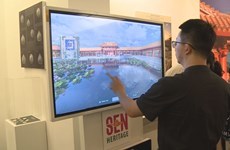 |
| At the exhibition “Discovering the architectural heritage of the One Pillar – Dien Huu Pagoda from the Ly Dynasty through VR technology” (Photo: baovanhoa.vn) |
Using 3D glasses, visitors can admire architectural models of Dien Huu Monastery Platform and its One Pillar Structure from the Ly Dynasty through 3D paintings, movies and VR3D products. With this technology, viewers can enjoy experiences perhaps not previously known: a virtual reality experience, architectural forms and the scale of the One Pillar – Dien Huu Pagoda. This method will help museums bring the artifacts closer to viewers so that they can discover its ancient heritage.
The access and application of virtual reality technology in museums to introduce artifacts to the public is a necessary way to promote from afar and attract more visitors, especially during COVID-19 prevention and control. In that context, a number of museums have initially made moves to convert documents and artifacts for viewers. Also following the trend, many online and 3D exhibitions have been launched and attracted viewers such as the Thang Long Citadel Conservation Centre’s 360-degree virtual online exhibition on the “D67 Revolutionary house and cellar”, unique visual art works on the resistance war against the US introduced online by the Vietnam Fine Arts Museum, and 3D exhibitions by Ho Chi Minh Museum.
In fact, in recent years, museums in Vietnam have been trying hard to use technology to attract the public, especially the young people. Vietnam National Museum of History is the pioneer in building 3D interactive virtual museums to increase the experience and interactive capacity of the real museum. Since 2013, catching up with the modernisation trend through the application of technology in displaying the activities of modern museums around the world, the Vietnam National Museum of History has introduced many exhibitions and collections to the public using 3D virtual reality technology. Visiting the museum’s website, viewers see the subject “3D Exhibition” with four virtual contents including “Vietnam in Prehistoric Times”, “The Dong Son culture”, “Ngo - Dinh - Anterior Le Dynasties, Ly – Tran Dynasties” and “Oc Eo – Phu Nam”. So far, the public has gradually become accustomed to using technology, smart phones and computers to access and enjoy online exhibitions and virtual interactions. Viewers can sit, watch and study the exhibits on display. The space between the museum artifacts and the public has narrowed. With just one click, the public have the chance to view heritage treasures and thematic exhibitions with narration and auxiliary sounds. Feedback from many viewers shows that virtual displays provide them with more detailed information than real exhibitions. For example, when observing the Ngoc Lu bronze drum in a glass cabinet at the museum, visitors cannot fully appreciate the value of this national treasure. However, with an 3D interactive virtual display, they can see both decorative details and information. Therefore, it is not surprising that there are nine million visits to the website of the Vietnam National Museum of History in 2019.
The Industrial revolution 4.0 with smart applications such as QR code scanning, 3D display, VR technology and augmented reality (AR) is not only a trend and opportunity but also a challenge for the museums. Although 3D VR museum cannot replace the real museum because the visual view of the original artifacts brings true historical feelings and emotions, the application of modern technology has significantly contributed to promoting the value of the exhibits more rapidly and effectively. Modern technology opens a new direction for data storage, conservation of cultural heritages, restoration and reproduction of ruins, serving the display and interpretation and promotion of Vietnamese heritages. The number of agencies developing “virtual museums” in Vietnam is still few, but a trend is developing and the fact that the museums cannot “stand still” in the context of technology development. NDO

Hanoi’s iconic pagoda given a new look with VR technology
Virtual reality (VR) technology has helped roll back 800 years to bring the famous One Pillar Pagoda – one of Vietnam's most iconic temples – to today’s audiences in a most vivid state.

Vietnamese museums apply digital technologies to attract visitors
Not only display pictures and movies, museums have nowadays applied digital technologies which are opening up new dimensions of the museum experience to attract visitors especially youngsters who are inclined to learn about history in museums.